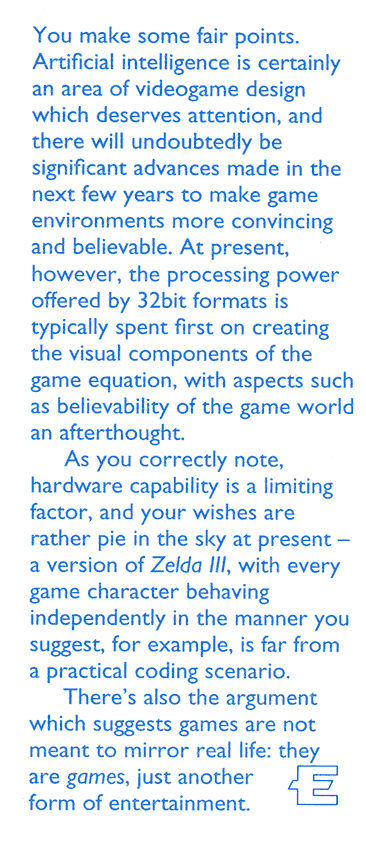Non-player characters
in an 8-bit World
Anders Hansson
Published in EDGE magazine May 1996
Playability is a quality often associated with 16-bit console games like the Mario series. In some respects those are fine games, but personally I find them, and almost all 16-bit console games, very boring. What these machines are lacking are games which create a believable world with computer-controlled characters which also act when not in the vicinity of the player.
It has always been possible to make games with such qualities but there have been far too few of them. To some degree, Defender can be held as a prime example – the scrolling is player-controlled and the aliens not only move when out of the screen, they are actually acting (capturing humans).
To me, qualities like these – not the size of the game world – are essential for the depth of a game. Without them, the illusion of being part of another reality is shattered, despite all efforts in other areas of game design.
Good examples of these qualities are found in some 8-bit computer games, like Argus Press’ The Detective for the C64 and Ocean’s The Great Escape. Both these games have a rather limited playing area which, considering the capacity of those machines, was necessary.
However, this may add to the atmosphere. Isolated hotels, running trains, islands and spaceships light years away from home – they all provide ideal settings for atmospheric dramas.
Many early adventures did, to some extent, succeed in giving the impression of living characters – Infocom’s games and Melbourne Houses’s classic, The Hobbit, whose sole merit (well almost) was the computer-controlled characters with whom you could interact. For the 16-bit computers, Millenium’s Robin Hood deserves a mention. Thanks to the successfully made-up miniature world it could be played in many ways.
Too many games compensate in this area. To me, a game is ruined if a computer-controlled character freezes when not in the area of the player. The suspense of knowing things happen out of view gives the time dimension a totally new role in game playing (well illustrated by Magnetic Scrolls’ text adventure Corruption). This allows for many new ways of problem construction far away from the ordinary and tedious “where to use an object”.
So far the 32-bit consoles have been a huge disappointment, with few, if any, games with the qualities described. The racing games, though, have been superb, but why-oh-why do the computer-controlled vehicles not run independently and why do they continue racing after having finished the set number of laps?
These qualities are, in a way, intimately dependent of processor speed and artificial intelligence, but neither has to be very high to provide a good impression by today’s standard. I, myself have a lot of ideas which could easily be realised on an 8-bit computer, and in my opinion those games would be miles ahead of most existing titles.
Comments from EDGE


